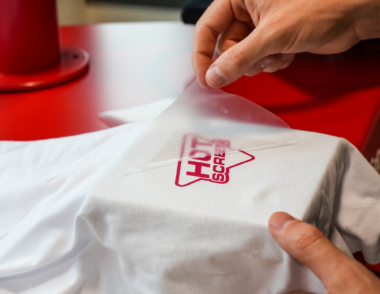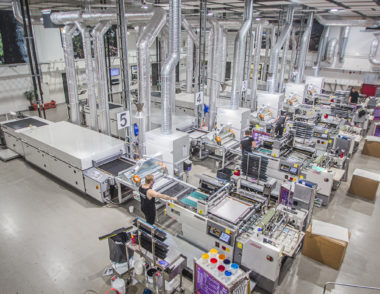About this article
Categories
Different materials have different requirements for garment printing, heat press settings, and the practitioner. It can be challenging to determine which type of heat transfer is suitable for a particular material, or what temperature and duration the press should be applied for. In the Print Guide, we gather articles with practical tips and tricks based on our extensive experience in garment embellishment. In this article, we’ll go through how to print on polyester to achieve a high-quality and durable result.
Polyester is a synthetic fiber made from oil, recycled plastic, agricultural products, or waste. The fiber is commonly used in the textile industry to make clothing with several excellent properties: it is lightweight, durable, wrinkle-resistant, and retains its shape and color even after multiple washes. Polyester is often combined with other fibers to add even more positive qualities to the material, making it particularly useful in the production of sportswear and outdoor clothing.

Despite its favorable properties, print on polyester can be a challenge. Our stretchable and flexible Flex Heat Transfer is specially designed for activewear and, when applied correctly, delivers a perfect end result. This transfer is our general recommendation. However, some polyester garments may “bleed” through the print, causing the color from the fabric to migrate through the transfer and discolor it. If you’re printing on the garment for the first time, we advise you to first test the material for bleeding or consult your supplier if they have prior experience with this issue.
If you don’t have time to test the garment, we recommend using the Stark Heat Transfer, our durable and robust transfer, along with the addition Blocker.
In addition to testing the garment for bleeding, the application of transfer print on polyester does not significantly differ from other materials. What determines the heat press settings is rather the type of transfer you choose to use. For Flex Heat Transfer, we recommend 130°C with 2 – 6 bars (depending on the size of the subplate) for 15 seconds. For Stark Heat Transfer, we recommend 160°C with 2 – 6 bars for 15 seconds. If you have one of our heat presses and are unsure about the settings, please feel free to contact our sales support.
About this article
Written by:
Christin
Categories
Related articles

Club clothing with a sustainable print
Read more

Printing machine for clothes - this is how they work!
Read more

My garments: upload your own garments to our ordering tool!
Read more
Yes! Our Flex Heat Transfer is specially designed for sportswear and activewear. However, some polyester materials may bleed through and discolor the print. We recommend that you first test your material for bleeding or consult your supplier. If time is limited, you can choose Stark Heat Transfer with the Blocker add-on.
When putting a print on polyester materials, you follow the same instructions as for other materials – it’s the transfer itself that determines the settings for your heat press. For Flex Heat Transfer, it’s 130°C, and for Stark Heat Transfer, it’s 160°C.
About this article
Written by:
Christin
Categories
Related articles

Club clothing with a sustainable print
Read more

Printing machine for clothes - this is how they work!
Read more

My garments: upload your own garments to our ordering tool!
Read more

Prints on workwear? Choose the heat transfer Stark!
Products
Tips & Tricks

The plotter print is a variation of our product Stark Heat Transfer.
Products

Learn more about the various print methods in the textile industry.
Print methods
Mon-Thu: 08.00-16.30
Fri: 08.00-15.30
Följ oss!
When you archive an article, it disappears from your webshop and is no longer orderable.
When you activate an article, it disappears from your archive and you can order it again